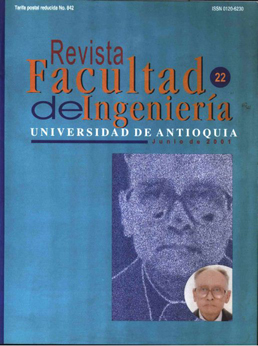El fenómeno del colapso de voltaje
DOI:
https://doi.org/10.17533/udea.redin.325957Palabras clave:
Estabilidad de voltaje, modelos de carga, compensación de la carga.Resumen
Durante muchos años los estudios de estabilidad de los sistemas de potencia han estado centrados en la estabilidad angular, buscando las medidas requeridas para mantener un sistema AC en sincronismo. Al tomar como criterio primordial de planificación lo anterior, los países desarrollados, debido al elevado progreso de su infraestructura eléctrica, se consideraban exentos de cualquier fenómeno que pudiera comprometer la continuidad del servicio o la seguridad de sus sistemas; la realidad demostró otra cosa, y los colapsos más grandes de los últimos veinte años se han presentado en países altamente desarrollados (Bélgica 1982, Florida 1982, Suecia 1983, Canadá 1986, Francia 1987, Tokio 1987, California 1996, etc.), como consecuencia de un fenómeno denominado colapso de voltaje.Descargas
Citas
Kundur, Prabha. Power System Stability and Control. Electric Power Research lnstitute (EPRI). McGrawH ill, Inc. 1994.
Taylor, Carson W. Power System Voltage Stability. Electric Power Research lnstitute (EPRI). McGrawHill, !ne. 1994.
Electric Power Research Institute (EPRI). Voltage Stability/Security Assessment and On-Line Control. Ontario Hydro, 1993.
Descargas
Publicado
Cómo citar
Número
Sección
Licencia
Los artículos disponibles en la Revista Facultad de Ingeniería, Universidad de Antioquia están bajo la licencia Creative Commons Attribution BY-NC-SA 4.0.
Eres libre de:
Compartir — copiar y redistribuir el material en cualquier medio o formato
Adaptar : remezclar, transformar y construir sobre el material.
Bajo los siguientes términos:
Reconocimiento : debe otorgar el crédito correspondiente , proporcionar un enlace a la licencia e indicar si se realizaron cambios . Puede hacerlo de cualquier manera razonable, pero no de ninguna manera que sugiera que el licenciante lo respalda a usted o su uso.
No comercial : no puede utilizar el material con fines comerciales .
Compartir igual : si remezcla, transforma o construye a partir del material, debe distribuir sus contribuciones bajo la misma licencia que el original.
El material publicado por la revista puede ser distribuido, copiado y exhibido por terceros si se dan los respectivos créditos a la revista, sin ningún costo. No se puede obtener ningún beneficio comercial y las obras derivadas tienen que estar bajo los mismos términos de licencia que el trabajo original.










 Twitter
Twitter